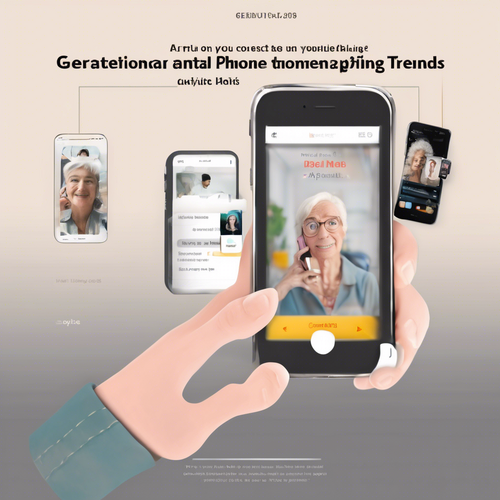The Latest Generational Divide: How to Hold a Phone
In a world where smartphones have become an extension of ourselves, it’s both fascinating and telling to observe the variations in how different generations hold their devices. While younger users may cradle their phones delicately, swiping with practiced precision, older users may grip their devices with a firm, steady hold, often squinting at the screen as if deciphering an ancient scroll. This seemingly trivial aspect of phone usage belies deeper sociocultural dynamics at play, revealing contrasting communication styles, habits, and even psychological underpinnings. 📱
A Window into Generational Preferences
Research shows that generational differences in smartphone usage are not merely anecdotal but are supported by data. A recent survey indicated that about 78% of Gen Z respondents reported feeling anxiety when separated from their phones, compared to just 36% of Baby Boomers. As the smartphone landscape evolves, so do the ways in which each generation interacts with this technology.
For the tech-savvy Gen Z, phones are not just tools—they symbolize their social identity. Their hold is often casual, even seemingly nonchalant, reflecting a comfort that invites frequent updates and social media engagement. On the other hand, older generations often approach their devices with a mix of caution and practicality, holding their phones securely as they navigate the digital landscape with careful clicks and taps. This divide is accentuated by the abrupt shift from physical communication to digital channels over the past two decades, making adaptation a necessary, if not always graceful, process. 👵🏻👦🏽
Cultural Implications of Phone Holding Styles
Interestingly, the differences in phone-holding techniques extend beyond mere comfort and ease. They also reflect cultural attitudes toward technology. Older individuals tend to adopt a more utilitarian approach—function over form—while younger users often gravitate toward aesthetics and the nuances of user experience.
“To hold a phone is to engage in a performance, showcasing not just our connectivity but our personality. Gen Z’s playful grip, often accompanied by an array of stickers and cases, contrasts sharply with the more formal aspects of Baby Boomers’ approach, which is largely utility-driven,” explains Dr. Lisa Tran, a cultural anthropologist. 📚
Swipe, Tap, Pinch: Examining Usage Patterns
Data further indicate that how people hold their phones correlates with their usage patterns. For instance, research shows that Gen Z users prefer touch interactions—swiping and pinching—leading to a more casual style of holding, often with one hand while multi-tasking. Alternatively, older adults, who may still be adapting to touch technology, often resort to using both hands for stability, a practice born out of necessity. This dual-handed grip allows for a more cautious navigation of their devices, particularly for those who report lower comfort with new technologies. 🙃
- Single-handed grip: Most commonly seen in younger users, characterized by a casual handling style that facilitates quick interactions.
- Two-handed grip: Often adopted by older generations, providing stability and control, combating the anxiety of a potential drop.
- Desk perched: A method seen almost universally—propping the phone up to facilitate video calls or multitasking while working.
Social Interactions and the Evolution of Communication
How we hold our phones impacts social interactions, both digitally and face-to-face. For younger generations, the act of checking notifications or texting mid-conversation is often viewed as acceptable, even normalized. In contrast, the older demographic often perceives this behavior as rude or dismissive—an unintentional breach of etiquette. The generational divergence thus breeds a new lexicon of social behaviors, reshaping the parameters of understanding in interpersonal communication. 🗣️
Addressing the Generational Gap
As the digital divide continues to evolve alongside burgeoning technological advancements, bridging the generational gap in smartphone etiquette becomes increasingly necessary. For instance, intergenerational workshops focusing on technology appreciation can enhance mutual understanding, helping individuals recognize the strengths and weaknesses embedded within their distinct approaches to smartphones.
Encouraging discussions about technology use between generations not only enriches understanding but also fosters a culture of patience and inclusivity, paving the way for collaborative learning to thrive, irrespective of age. 🤝
Conclusion: A Shared Future Beyond the Divide
The simple act of holding a phone may seem trifling, yet beneath its surface lies an intricate web of generational differences that shape our communication, culture, and society at large. Embracing these differences can lead to a richer, more connected experience for all, enabling us to navigate an increasingly digital world while celebrating our unique perspectives. As we continue to evolve alongside our technology, adopting an open-minded approach towards generational differences will ensure smoother interactions, fruitful conversations, and a shared future of understanding. 🌏












Im convinced that phone holding styles are the new way to judge someones personality. Are you a swiper or a pincher? Lets discuss!
I think phone holding styles are overrated. Lets focus on more important generational divides like avocado toast preferences! 🥑📱